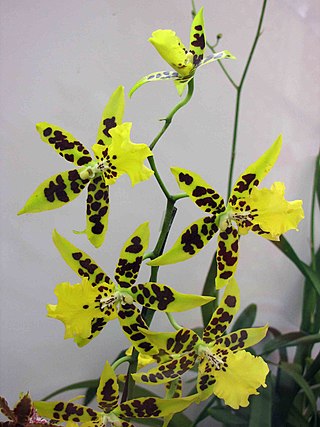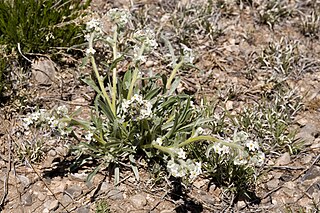
Royal Botanic Gardens, Kew is a non-departmental public body in the United Kingdom sponsored by the Department for Environment, Food and Rural Affairs. An internationally important botanical research and education institution, it employs 1,100 staff. Its board of trustees is chaired by Dame Amelia Fawcett.

Arabidopsis (rockcress) is a genus in the family Brassicaceae. They are small flowering plants related to cabbage and mustard. This genus is of great interest since it contains thale cress, one of the model organisms used for studying plant biology and the first plant to have its entire genome sequenced. Changes in thale cress are easily observed, making it a very useful model.

In the botanical classification of plants, Aeridinae Pfitzer is a subtribe of the tribe Vandeae whose representatives all have a monopodial growth habit and do not possess pseudobulbs.

Hesperocyparis arizonica, the Arizona cypress, is a North American species of tree in the cypress family Cupressaceae, native to the southwestern United States and Mexico. Populations may be scattered rather than in large, dense stands.

Carl Johan Fredrik Skottsberg was a Swedish botanist and explorer of Antarctica.

Selenicereus, sometimes known as moonlight cactus, is a genus of epiphytic, lithophytic, and terrestrial cacti, found in Mexico, Central America, the Caribbean and northern South America. The term night-blooming cereus is also sometimes used, but this is also used for many night-blooming cacti, including Epiphyllum and Peniocereus. In 2017, the genus Hylocereus was brought into synonymy with Selenicereus. A number of species of Selenicereus produce fruit that is eaten. The fruit, known as pitaya or pitahaya in Spanish or as dragon fruit, may be collected from the wild or the plants may be cultivated.
Bulbophyllum deshmukhii, synonym Genyorchis macrantha, is a species of plant in the family Orchidaceae. It is endemic to Cameroon. Its natural habitat is subtropical or tropical dry forests.

Opuntia galapageia is a species of cactus. It is endemic to the Galápagos Islands, part of Ecuador. Forms occurring on different islands have been treated as separate species and subtaxa of these species. Opuntia echios, Opuntia helleri, Opuntia insularis, Opuntia megasperma, Opuntia myriacantha and Opuntia saxicola are now sunk within O. galapageia.

× Brassidium, abbreviated in trade journals Brsdm, is an artificial intergeneric hybrid between the orchid genera Brassia and Oncidium. When Cochlioda and Odontoglossum are sunk into Oncidium, × Maclellanara (Mclna.), × Odontobrassia (Odbrs.) and × Sanderara (Sand.) are synonyms.

Sairocarpus cornutus, synonym Antirrhinum cornutum, is an uncommon species of New World flowering plant in the family Plantaginaceae, known by the common name spurred snapdragon.

Nymphaea nouchali, often known by its synonym Nymphaea stellata, or by common names blue lotus, star lotus, red water lily, dwarf aquarium lily, blue water lily, blue star water lily or manel flower, is a water lily of genus Nymphaea. It is native to southern and eastern parts of Asia, and is the national flower of Bangladesh and Sri Lanka. In Sanskrit it is called utpala. This species is usually considered to include the blue Egyptian lotus N. nouchali var. caerulea. In the past, taxonomic confusion has occurred, with the name Nymphaea nouchali incorrectly applied to Nymphaea pubescens.

Triglochin scilloides, synonym Lilaea scilloides, is a species of aquatic plants native from western Canada to Mexico, and to western and southern South America. It has been introduced into Portugal and Spain. English names include flowering quillwort. At one time, it was the only species accepted in the genus Lilaea.
Clappia suaedifolia is the sole species in the North American genus of flowering plants in the family Asteraceae, Clappia.

Solenangis is a genus of flowering plants from the orchid family, Orchidaceae. It is native to sub-Saharan Africa.

Lumnitzera is an Indo-West Pacific mangrove genus in the family Combretaceae. An English common name is black mangrove. Lumnitzera, named after the German botanist, Stephan Lumnitzer (1750-1806), occurs in mangroves from East Africa to the Western Pacific, and northern Australia.
The Plant List was a list of botanical names of species of plants created by the Royal Botanic Gardens, Kew and the Missouri Botanical Garden and launched in 2010. It was intended to be a comprehensive record of all known names of plant species over time, and was produced in response to Target 1 of the 2002–2010 Global Strategy for Plant Conservation, to produce "An online flora of all known plants". It has not been updated since 2013, and has been superseded by World Flora Online.

Cassia javanica, also known as Java cassia, pink shower, apple blossom tree and rainbow shower tree, is a species of tree in the family Fabaceae. Its origin is in Southeast Asia, but it has been extensively grown in tropical areas worldwide as a garden tree owing to its beautiful crimson and pink flower bunches.

The World Checklist of Selected Plant Families was an "international collaborative programme that provides the latest peer reviewed and published opinions on the accepted scientific names and synonyms of selected plant families." Maintained by the Royal Botanic Gardens, Kew, it was available online, allowing searches for the names of families, genera and species, as well as the ability to create checklists.

Anne M. Schot is a Dutch botanist.

Oreocarya suffruticosa is a species of flowering plant in the family Boraginaceae, native to the west and central United States and to northern Mexico. It was first described by John Torrey in 1827 as Myosotis suffruticosa and transferred to Oreocarya by Edward Lee Greene in 1887. Varieties of Oreocarya suffruticosa have previously been placed within several species of Cryptantha, including Cryptantha cinerea, Cryptantha jamesii and Cryptantha pustulosa.


















